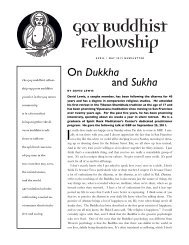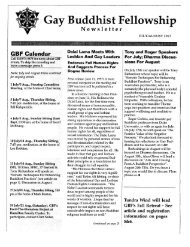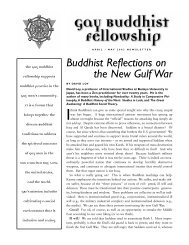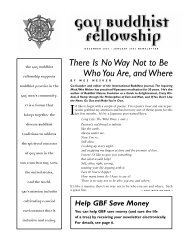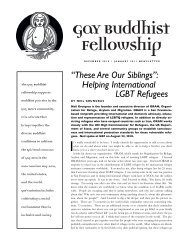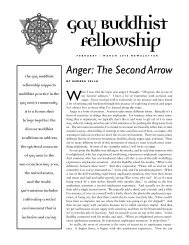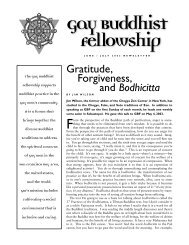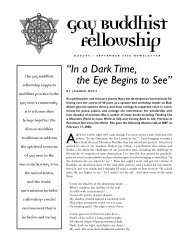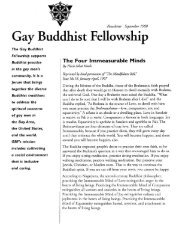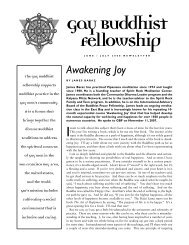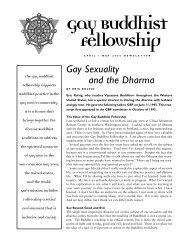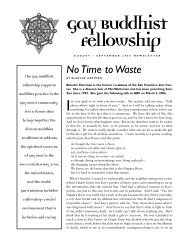2007.02 Furyu Nancy Schroeder - Gay Buddhist Fellowship
2007.02 Furyu Nancy Schroeder - Gay Buddhist Fellowship
2007.02 Furyu Nancy Schroeder - Gay Buddhist Fellowship
Create successful ePaper yourself
Turn your PDF publications into a flip-book with our unique Google optimized e-Paper software.
<strong>Gay</strong> <strong>Buddhist</strong><br />
<strong>Fellowship</strong><br />
F E B R U A R Y / M A R C H 2 0 0 7 N E W S L E T T E R<br />
The <strong>Gay</strong> <strong>Buddhist</strong><br />
<strong>Fellowship</strong> supports<br />
<strong>Buddhist</strong> practice in the<br />
<strong>Gay</strong> men’s community.<br />
It is a forum that<br />
brings together the<br />
diverse <strong>Buddhist</strong><br />
traditions to address<br />
the spiritual concerns<br />
of <strong>Gay</strong> men in the<br />
San Francisco Bay Area,<br />
the United States,<br />
and the world.<br />
GBF’s mission includes<br />
cultivating a social<br />
environment that is<br />
inclusive and caring.<br />
The True Self<br />
BY FURYU NANCY SCHROEDER<br />
<strong>Furyu</strong> <strong>Nancy</strong> <strong>Schroeder</strong> has been with the San Francisco Zen Center since<br />
1976, was ordained a <strong>Buddhist</strong> priest in 1986, and is a dharma heir of Tenshin<br />
Reb Anderson. She is currently director of Green Gulch Farm. She spoke to<br />
GBF on November 5, 2006.<br />
In keeping with the season of Halloween, and the changing of our world from hot<br />
to cold and light to dark, I thought I'd tell you a ghost story. This story is from<br />
the Chinese Zen tradition. Actually it's a folk story that was taken by the Zen<br />
people to illustrate an important aspect of the human being. It was recommended to<br />
me when I was a student at Tassajara many years ago. I was probably in my early<br />
thirties and thoroughly miserable. I was doing practice periods in the monastery. We<br />
were in our winter season. I don't know how it is for some of you, but for me that<br />
time of year was a time when I really descended into the dark elements of my own<br />
mind and feelings, and a dark sense of dread would come on me. The abbot at that<br />
time was Mel Weitsman, who is the abbot of the Berkeley Zen Center, and he said<br />
to me, “You really need to read the story of Seijo and her soul.”<br />
So this is from Case 35 of the Mumonkan, the collection of koans which translated<br />
means “The Gateless Barrier” or “The Gateless Gift.” The term koan actually<br />
translates as a “public case.” In the Zen tradition, a koan would be a story, a teaching<br />
story, something that happened in public. Maybe some of us would have an<br />
exchange that would be memorable in some way or thought-provoking, and maybe<br />
someone else would write that down. He said, and then he said, and oh, that was<br />
interesting. So they would write it down and repeat it, and if it had a lot of juice, it<br />
might go on for several generations as these koans have. Most people think of the<br />
koan as a puzzle that is not to be solved but rather to disturb you and to challenge<br />
your usual way of understanding things, particularly yourself.<br />
This koan is a little lengthy, but here we go. Once upon a time, there lived an old<br />
man named Chokan. Chokan loved his daughter Seijo very much. She was a beautiful<br />
girl, and he used to tell her while she was still young, “You're almost as good<br />
looking as your cousin, the handsome Ochu.” So about the time these two cousins<br />
became teenagers, they had fallen in love. But the father, Chokan, announced the<br />
choice of another man as husband for Seijo, and the two young people were devastated<br />
with the news. Not able to bear the thought that the beautiful Seijo was going<br />
to marry someone else, Ochu left the village at night, setting off in a small boat. He
had rowed a distance when he saw someone running along<br />
the bank in the moonlight. At first, he thought it was a ghost,<br />
so he rowed faster. Then he realized with great joy that it was<br />
his beloved Seijo, who had followed him to the river. They<br />
reunited and decided to travel to a far-off land and become<br />
married and live a life together. And then many years later,<br />
when Seijo became a mother herself, she realized for the first<br />
time that parents' love for their children is profound. She<br />
began to feel a lot of remorse for leaving her own family. So<br />
she talked to her husband, and they agreed they would go<br />
back to their village and ask for forgiveness.<br />
When they arrived in their village, Seijo remained in the<br />
boat while Ochu went to apologize to Chokan and tell him<br />
what had happened. The old man listened, but he didn't seem<br />
to understand what Ochu was saying. Finally, Chokam asked<br />
Ochu, “Who are you talking about?” The young husband<br />
replied, “I'm talking about your daughter Seijo, of course. We<br />
had run away, and now we have returned.” The old man just<br />
shook his head in disbelief. “But my daughter never left<br />
home!” the old man exclaimed. “She hasn't left her bed or<br />
uttered a single word since you left.” “You're mistaken,”<br />
Ochu replied. “Seijo followed me, and we went together to a<br />
far-off country. We are married now and have two fine children.<br />
She is in excellent health and wants to see you again and<br />
ask your forgiveness for running away and marrying without<br />
your permission. If you don't believe me, come down to the<br />
boat and see for yourself.”<br />
The old man was reluctant, so Ochu went alone to the boat<br />
to bring Seijo back to her father's house. In the meantime,<br />
Chokan, the father, went into the bedroom to tell the sick<br />
Seijo what was happening. Without a word, the invalid rose<br />
from her bed and rushed out to meet the approaching Seijo.<br />
As the two embraced, they became one.<br />
So the Zen master says to us, to me, to all of you, “Which<br />
is the true Seijo? Which is the true fool? Which is the true each<br />
of those names you all say to yourselves? Which is the true<br />
one of you? Is there one? Are you whole?”<br />
This question, or koan, serves like a light, like a lantern. If<br />
we are willing to look inside ourselves, perhaps there is a dispossessed<br />
part, a part of ourselves that stayed an invalid, that<br />
never really came to life. And then meanwhile, the other part<br />
went along and had a life, stayed busy, found a job, perhaps a<br />
relationship, perhaps not. Anyway, off you went; off she went.<br />
If this is so, the koan may resonate for you. It certainly did for<br />
me—the idea of there being maybe more than two, but at least<br />
We call the kind of meditation we do in Zen the “objectless awareness.” We<br />
take no object. Object would mean subject, two things, split off.There is no<br />
object, subject only, mind only. No separate external thing.When the Buddha<br />
looked at the night sky as dawn was breaking, he saw a star and he said,<br />
“I get it.” What did he get? This is the big question. What did the Buddha<br />
see when he saw the star? I say he saw nothing outside.The star wasn't outside<br />
himself; it was co-extensive with himself. You don't have seeing without<br />
an object and a subject. You can do away with one of those—either<br />
object only or subject only; either way it doesn't matter.There is no separation<br />
between seeing and that which is seen.<br />
there are two here: one that was frozen and protective and perhaps<br />
hidden away, and one that went about her daily life feeling<br />
as though she were missing a big part of herself.<br />
In the language of <strong>Buddhist</strong> teaching, this frozen quality<br />
that may be inside of us is called samsara. It's the frozenness<br />
of going through circles of familiarity, the same pattern day<br />
after day, the same way of thinking, the same way of reacting,<br />
over and over again. That's frozen, frozen in the familiar. So<br />
the other Seijo, the one that ran away with her lover down the<br />
river, looks like the better choice, doesn't it? “Well I'll just<br />
escape. I won't be frozen; I'll run away.” But this is the other<br />
kind of samsara, the endless circling of “I'll just run away. I'll<br />
just leave this situation and go to a better situation.” This is<br />
also a pattern. In <strong>Buddhist</strong> understanding, this is called<br />
“turning away” or “touching,” and either way we abandon<br />
one half of ourselves.<br />
I was thinking of this part of myself that was filled with<br />
pain, and I have this image of a sow bug, kind of curled up<br />
around the difficulty and hiding away inside, very afraid and<br />
tender and protective. And then there's the daily life, as I said.<br />
You know, there we go, on with our daily life.<br />
This feeling of separation is what this koan is about. How<br />
have we split ourselves off? For some years now I've been<br />
reading about Western psychological theory, and there is one<br />
particular teacher who basically says that the primary or the<br />
fundamental illness for the human being is duplicity, that<br />
there are two of us. This therapist, Helmut Kaiser I believe<br />
was his name, would invite a client into his office in his home,<br />
and he wouldn't say anything at all. And very soon the per-<br />
2 GBF F E B R U A R Y / M A R C H 2 0 0 7 N E W S L E T T E R
son would get a little uncomfortable and say, “Well, don't you<br />
want to ask me some questions?” and he would say, “Would<br />
you like me to ask you some questions?” “Well aren't you<br />
supposed to find out something about me?” “Well, would you<br />
like to tell me something about you?” He would just basically<br />
leave the person there, and little by little in each case the<br />
people would begin to show these two sides of themselves<br />
over and over, so he called this the universal symptom, duplicity.<br />
That fearful one, the one who wants someone else to tell<br />
him what to do, or is just kind of hiding inside. And then<br />
there are these behaviors that we do to not let anyone know,<br />
we hope, how it is, how that protected one is inside.<br />
This question—which is the true Seijo? Which is the true<br />
Fu?—over and over again, is the working of the koan: how to<br />
find the answer myself to this question. The teaching says<br />
there is a name that we have that is our true name. And you<br />
could say, as each of you did, that name that each of you have,<br />
but I've always felt that one was a little wrong, you know,<br />
“My name is Bob,” or “My name is Bill,” or “My name is<br />
Fu.” I don't know. Is that my name? Is that my true name?<br />
The Buddha said your true name is what you really are. It is<br />
not so much what you are called, but what you really are.<br />
And what you really are is awake. You are awake; that is the<br />
quality that you have that is characteristic of a living being.<br />
the same breakfast that you usually do, and made coffee the<br />
way I usually make it. So all of those different experiences are<br />
what master Mumonkan is calling the “husks.” They are like<br />
these little experiential pods. We pass from one to the other.<br />
But who is it that is passing through these experiences? This<br />
is true self, awake. There is awareness that is moving through<br />
these different husks, one after the other, and as we leave one,<br />
the other one simply vanishes. Another image is going from<br />
room to room in a great house. Some rooms are red; some are<br />
blue; some are happy or unhappy. But through them all we<br />
go, awake, awake, walking through each of these different<br />
qualities of life: angry, happy, unhappy, excited, in love, angry.<br />
In and out, in and out. In this process of living, who is the<br />
one that is awake? Where is the one that's awake? Your true<br />
self, your true name?<br />
Suzuki Roshi says, “Your true self is always on your side. It<br />
is not the object of anything. It is always the subject.” These<br />
are clues wherever you look for your true self, for awake.<br />
What is it to be an awakened being? But you are. I am. Why<br />
do we forget? It is so simple, like water running through our<br />
bodies. It is just clear awakened awareness. It is clarity, this<br />
clear thinking of the mind. But we get very drawn to the<br />
objects. We get all involved in the objects of our lives, objects<br />
like thinking, objects like colors, sounds, objects that we think<br />
It is not uncommon for people when they begin meditation to encounter<br />
some fear, some dread, in fact, even terror. Maybe there's nothing there.<br />
Your true self may be something you can't find. It's not the one who is<br />
busy. It's not the one you count on, the one who likes blue better than<br />
yellow.That preferential personality you have is not your true self. ...If<br />
we risk this person, if we are willing to risk this person that we carefully<br />
assembled, if we are willing to let that go long enough to look, there is a<br />
true self that is there. It is silent and vast and connected, and belongs,<br />
and is content and tranquil and peaceful, and it kind of looks like this<br />
image of the Buddha.<br />
The name for the word awake is “Buddha”; that is what the<br />
word means. That doesn't apply to anybody; it applies to life<br />
itself. We are awake. We know that; you all know that. What<br />
you are going to do about that—that's more complicated.<br />
What to do with being awake, with being alive—we are a little<br />
bit confused about that. Now what?<br />
In his commentary on this koan, Master Mumonkan says,<br />
"When you realize what the real you is, you will see that we<br />
just pass from one husk to another like travelers stopping for<br />
a night's lodging.” And these husks are experiences that we<br />
have throughout the day. Let's just say this morning. How<br />
was it this morning? Well, you woke up. Were you surprised?<br />
Were you somewhere unusual? Or you woke up to the familiar,<br />
perhaps, to the cycle of familiarity. You got up; you did<br />
we don't have, that we want. If you turn the light around,<br />
onto yourself, onto your awareness itself, that's your true self,<br />
awake. I am awake.<br />
Part of the difficulty we have encountering this quality of<br />
ourselves, this true self, is the “busy one,” the one who is going<br />
about the day, making coffee, taking care of things, answering<br />
the phone, doing their jobs, driving the car. So the busy one<br />
has an important function. He kinds of keeps us ahead of that<br />
anxiety we might feel when the business stops. It is pretty common<br />
for human beings to get a little scared when it gets too<br />
quiet. I have a mom who talks a lot, almost constantly. I was<br />
driving in the car with her one day, and I said to her—it felt<br />
very brave to say it —“Mom, would you mind being quiet for<br />
just about five minutes and see what happens? How is that for<br />
GBF F E B R U A R Y / M A R C H 2 0 0 7 N E W S L E T T E R 3
you?” She said, “Oh, I can do that; I can do that.” About two<br />
minutes later she said, “Has it been five minutes?” and I said,<br />
“No, no, I'll let you know.” So then I asked her, “How was<br />
that for you?” and she said, “I get scared.”<br />
It was such a revelation for me. It is not uncommon for<br />
people when they begin meditation to encounter some fear,<br />
some dread, in fact, even terror. Maybe there's nothing there.<br />
Your true self may be something you can't find. It's not the<br />
one who is busy. It's not the one you count on, the one who<br />
likes blue better than yellow. That preferential personality you<br />
have is not your true self. In fact, you don't even know who<br />
that is. It's sort of evolved from when you were little, and you<br />
that in high school. We are not actually taught how we really<br />
are, what it's really like, but we know it. We actually know<br />
it because we are that, but our language doesn't tell us and<br />
our schooling doesn't tell us. We are uncomfortable because,<br />
wait a minute, I am this non-separate, aware being.<br />
So tranquility practice, or samatha practice, is the practice<br />
of calming the mind, the human mind which runs almost nonstop<br />
with what we call discursive thinking, like the radio program<br />
that is on all the time—we each have one, probably in<br />
your own voice. For English speakers, it speaks English; for<br />
Spanish speakers it speaks Spanish. Isn't that funny? On and<br />
on and on. So the idea for practice, for meditation, is to quiet<br />
To my teacher one time I said, “Is this Zen thing fast enough? It just feels<br />
like the world is getting worse! It hasn't stopped the fighting; it hasn't<br />
stopped anything. It's just as bad as it always was! I don't feel like it's making<br />
a big change.” And he said,“Well, perhaps the world is safer from you.”<br />
packed it in and made some choices, and then you stuck to<br />
them, or they stuck to you. So there you are; you're a person.<br />
If we risk this person, if we are willing to risk this person that<br />
we carefully assembled, if we are willing to let that go long<br />
enough to look, there is a true self that is there. It is silent and<br />
vast and connected, and belongs, and is content and tranquil<br />
and peaceful, and it kind of looks like this image of the Buddha.<br />
That's a human being at peace. Just like us, same shape,<br />
same number of arms and legs and toes. It's a person at peace.<br />
That's what each of us looks like when we find that place.<br />
Dropped away, dropped off, a person dropped off. It's a great<br />
relief. It ought to be a great relief, and you don't have to<br />
worry because, he'll come back. He won't stay away for long.<br />
It's like a coat in the closet. He'll come right back. So it's<br />
nothing really to be worried about.<br />
So we practice tranquility. That is what we were doing this<br />
morning, practicing tranquility, so we can have access to this<br />
experience of ourselves, as the peaceful one, as the one who is<br />
awake, the subject without the object. We call the kind of<br />
meditation we do in Zen the “objectless awareness.” We take<br />
no object. Object would mean subject, two things, split off.<br />
There is no object, subject only, mind only. No separate external<br />
thing. When the Buddha looked at the night sky as dawn<br />
was breaking, he saw a star and he said, “I get it.” What did<br />
he get? This is the big question. What did the Buddha see<br />
when he saw the star? I say he saw nothing outside. The star<br />
wasn't outside himself; it was co-extensive with himself. You<br />
don't have seeing without an object and a subject. You can do<br />
away with one of those—either object only or subject only;<br />
either way it doesn't matter. There is no separation between<br />
seeing and that which is seen. We've never seen a thing outside.<br />
We've never heard a thing outside. Hearing and sound<br />
are one. Seeing and that which is seen are one. We don't learn<br />
that discursive mind, to turn it down. The best I usually can<br />
do is a mumble. Somebody is mumbling in my right leg.<br />
Shhhh! It's tolerable. And when that happens, when this discursive<br />
thinking actually quiets, there is this spaciousness, this<br />
openness that is always there. We get distracted by our thinking.<br />
Thinking is very powerful. Thinging. Think and thing<br />
come from the same root. We make things by thinking. I just<br />
made this pillow. It wasn't there until I said so. It wasn't there<br />
for me. I give it a feeling. I give it a color. So we “thing” the<br />
world into being, and then we complain! That's not the way<br />
I want it to be! There's a little tension there.<br />
Samatha practice, tranquility practice, is one of the two<br />
major elements of meditation. Calming the mind is step one.<br />
In all traditions of Buddhism, that practice is taught. It's primary—samatha,<br />
tranquility. And the basic practices are<br />
almost all the same. There are lots of subtle variations, but in<br />
the four foundations of mindfulness the Buddha teaches the<br />
first foundation of mindfulness is mindfulness of the body<br />
because it is the grossest level of our experience of ourselves.<br />
You can locate the body; most can find it somewhere around<br />
here. So you locate your body, your experiences of your body,<br />
and you focus on those. The first foundation of mindfulness,<br />
and the element of the body that is the most available to us<br />
and the most reliable as an object of meditation, is the breath.<br />
(I'm contradicting myself a little bit. I said no objects, but this<br />
is a preliminary practice to enter into objectless meditation.<br />
We start with objects, so the object of our meditation is the<br />
breath.) You can feel your breath, so it is very handy. At any<br />
time of the day, if you're feeling agitated, if you're driving or<br />
sitting at a desk, or whatever you're doing, find your breath,<br />
and just stay with it. If you're arguing with somebody, find<br />
your breath, and stay with your breath. Quite naturally you'll<br />
begin to calm. This is tranquility practice. I generally give<br />
4 GBF F E B R U A R Y / M A R C H 2 0 0 7 N E W S L E T T E R
introductory <strong>Buddhist</strong> meditation as breath practice: follow<br />
your breath; follow your breath, until the questions are gone,<br />
until the “then what's” are gone.<br />
Once you calm, you don't want to leave that space. That's<br />
why we ring the bell. Otherwise, you wouldn't want to get<br />
up. How pleasant it is to be calm. Our practice is to come<br />
from tranquility back to busyness and then back to tranquility.<br />
Some people call it yo-yo Zen. You calm down, and then<br />
you do a lot of work, fast. We sometimes get students who<br />
think meditation is about going really slow. So they go in the<br />
kitchen, you give them a carrot, and then they go in slow<br />
motion. And we go, “No, no, no. You can do it really fast,<br />
without losing your tranquility.” It's not about speed; it's<br />
about concentration—samadi. It means one pointed concentration.<br />
You've calmed down, and you're focused and concentrated,<br />
and now you can work from there, and you don't<br />
get distracted, and you don't snip your fingers.<br />
I guess it's an exciting part of our practice to bring it into<br />
our lives, bring that tranquility and focus into your daily life,<br />
into your work, into your driving, into your walking. So again,<br />
mindfulness of the body: How is your spine? How is your<br />
head? Are your ears lined up with your shoulders? Is your<br />
spine straight? I usually suggest you take a look at a two-yearold<br />
if you want to remember how to hold your body when you<br />
walk. They're perfect! They've just learned how to walk, and<br />
they're totally upright, perfectly balanced. Then, when they get<br />
claim your upright posture—I think there is something more<br />
going on there. I was talking to someone this morning, and I<br />
said, "How would it feel if you just stretched your spine up<br />
and sat up straight?" And she did it. It looked very nice, and<br />
then she said, “This is scary.” I said, “OK, I understand. It is<br />
scary.” She said, “I feel exposed.” I said, “Yeah, that's right,<br />
we are exposed. We are the sowbugs uncurled.” We have to<br />
rely on strangers for kindness—to protect us.<br />
To my teacher one time I said, “Is this Zen thing fast<br />
enough? It just feels like the world is getting worse! It hasn't<br />
stopped the fighting; it hasn't stopped anything. It's just as bad<br />
as it always was! I don't feel like it's making a big change.”<br />
And he said, “Well, perhaps the world is safer from you.”<br />
Suzuki Roshi said, “Sooner or later we die, and we go to<br />
the same place we go when we sat Zazen.” I think that's such<br />
a relief, and I think it's true. When that discursive mind is<br />
quiet and you're not thinking, “thinging” the world, that's the<br />
perfect peaceful place. And I think when we die, that's where<br />
we go. I trust him. I'm going to hold him to that.<br />
I think that's most of what I wanted to say. I would like to<br />
close with a poem. This is from the koan, Seijo's koan. So<br />
Seijo is now of a piece. She has come home; she has reunited<br />
with her parents, with her village, with her own family, her<br />
own children, her spouse of her choosing, herself—she has<br />
become whole. So this is the outcome of a life with practice.<br />
If you have no other aspiration, that's really the aspiration I<br />
The Buddha said your true name is what you really are. It is not so much<br />
what you are called, but what you really are. And what you really are is<br />
awake.You are awake; that is the quality that you have that is characteristic<br />
of a living being.The name for the word awake is "Buddha"; that is what<br />
the word means.That doesn't apply to anybody; it applies to life itself.We<br />
are awake. We know that; you all know that. What you are going to do<br />
about that-that's more complicated. What to do with being awake, with<br />
being alive-we are a little bit confused about that. Now what?<br />
to be about fourteen, they go like this—curling up—the sowbug<br />
starts to come in. Teenagers are amazing. It's almost like<br />
a law that you cannot stand up straight if you're a teenager—<br />
at least not in our culture. They are required to collapse. So we<br />
have to kind of decide which way we want to go—toward the<br />
natural alignment of our body? It's a healthy way to hold<br />
yourself. Your lungs are open, your head is balanced, and<br />
you're not carrying your weight on your shoulders. Your head<br />
is very heavy. If you carry it forward—if you watch people<br />
walking, especially in downtown San Francisco, their heads<br />
are forward; they're late. It looks like that, like everybody is<br />
late. You know, you can be late with your head above your<br />
shoulders. You can be on time the same way too, you know.<br />
Feet go first. But there is something about that willingness to<br />
think we're all really longing for: to be whole, to be at home,<br />
to belong, wherever we are, to belong. So that every moment,<br />
we are embracing and embraced by all the colors and textures<br />
and sounds, so that there is nothing other than sound and texture<br />
and color. You are that: you are all you see; you are all<br />
you hear; you are all you feel; you are all of that.<br />
Here is a poem from this koan:<br />
The clouds and the moon are the same.<br />
Valleys and mountains are different from each other.<br />
All are blessed. All are blessed.<br />
Ten thousand blessings. Ten thousand blessings.<br />
Is this one?<br />
Is this two?<br />
■<br />
GBF F E B R U A R Y / M A R C H 2 0 0 7 N E W S L E T T E R 5
G B F<br />
STEERING COMMITTEE<br />
Paul Albert<br />
Ray Dyer<br />
Richard Hedden<br />
Jim Stewart<br />
Don Weipert<br />
TREASURER<br />
Teng-How Bae<br />
NEWSLETTER<br />
Editor<br />
Michael Langdon<br />
Contributing Editor<br />
Roger Corless<br />
Design / Layout<br />
Michael Gabel<br />
Transcribers<br />
Darin Little<br />
Jim Stewart<br />
Mailing List<br />
Todd Pope<br />
Newsletter Mailing<br />
Jack Busby<br />
MAIL<br />
Bill Chiles<br />
HAMILTON HOUSE<br />
Volunteer Coordinator<br />
Clint Seiter<br />
PRISON OUTREACH<br />
Coordinator<br />
Baruch Golden<br />
WEBSITE<br />
Webmaster<br />
Joe Kukulka<br />
SUNDAY SITTINGS<br />
Program Committee<br />
Paul Albert<br />
Dean Bellerby<br />
Howard DePorte<br />
Baruch Gold<br />
Darin Little<br />
Jim Stewart<br />
Speaker Coordinator<br />
Jim Stewart<br />
Facilitator Coordinator<br />
Ray Dyer<br />
Facilitators<br />
Dean Bellerby<br />
Peter Camarda<br />
Ray Dyer<br />
Bob Siedle-Khan<br />
Marvin Snow<br />
Host Coordinator<br />
Kei Matsuda<br />
Hosts<br />
Bill Addison<br />
Cass Brayton<br />
Jay Corbett<br />
Francis Gates<br />
Richard Hedden<br />
Carl Lasagna<br />
Dave Limcaco<br />
Kei Matsuda<br />
Todd Pope<br />
Paul Shepard<br />
Harv Whitten<br />
Nobu Yamaji<br />
Sound / Recordings<br />
C J Grant<br />
GBF Theatre Party on February 17th<br />
There will be a theatre party on Saturday, February 17, to see Sam Shepard's classic<br />
True West, hailed by the New York Times as “a great American play, arguably Mr.<br />
Shepard's finest.” The play is directed by GBF member Paul Shepard, who describes<br />
it as “a dark comedy about two feuding brothers: Austin, an aspiring screenwriter,<br />
and Lee, a vagrant flimflam man who attempts to sabotage a film deal that Austin<br />
is making with a movie producer. As the play progresses toward its violent climax,<br />
we see each brother's identity morphing into the other's.”<br />
The play begins at 8:00 at Live Oak Park Theatre. Complete information about<br />
the play, including directions to the theatre in Berkeley, can be found at www.aeofberkeley.org.<br />
After the play, GBF facilitator Marvin Snow has offered to host the<br />
closing night party to which GBF members are invited. He lives in the Berkeley<br />
Hills above the theatre at 2 Northgate Ave., Berkeley, 94708. GBF members are<br />
asked to RSVP to Marvin at (510) 898-3229. Use our e-mail group if you need to<br />
arrange for a ride, or ask at announcement time at the Sunday meetings.<br />
We had a prior theatre party on January 6 which was most successful. We found<br />
it was a wonderful way to build sangha.<br />
The Uncertain Future of<br />
LGBTQ Retreats at Spirit Rock<br />
BY LARRY YANG<br />
I have received a letter from Urusa Fahim, who is the Diversity Coordinator at Spirit<br />
Rock. After many years of dialogue about the LGBTQ retreat, my understanding<br />
of the situation is that Spirit Rock is unable to maintain the future 2008 LGBTQ<br />
residential retreat as it has been handled in the past (the up and coming 2007<br />
LGBTQ retreat is planned as it has been in previous years). Much of this is related<br />
to the increasing financial burden of running retreats and the growth of Spirit Rock<br />
as a meditation center. You should be aware that the LGBTQ retreat is not the only<br />
retreat facing these issues. Other retreats that have not filled to capacity (about 85<br />
participants is a "full retreat") are also in a similar position of being pulled off-site<br />
to smaller retreat facilities. [FYI, the LGBTQ retreat currently draws around 50-55<br />
participants each year.]<br />
The two options in Urusa's letter that Spirit Rock has come up with are: (1) to<br />
have the retreat off-site at the Angela Center in Santa Rosa, but have lower levels of<br />
financial assistance available for off-site retreats due to current financial aid policy<br />
determined by the Board (i.e. the retreat would cost at minimum $35-40 per night<br />
for a 5-night retreat), or (2) to keep the retreat at Spirit Rock with the current levels<br />
of financial assistance uncompromised for those who need it, but to have a concurrent<br />
"parallel" retreat happen at the same time (to fill all available retreat spots).<br />
What these two options do not articulate are any other possible solutions to the<br />
intersecting, complex needs of the LGBTQ community and those of Spirit Rock. It<br />
is critical for you to become involved in this discussion, if you have any interest in<br />
the LGBTQ retreats at Spirit Rock. I highly encourage you to present any ideas you<br />
have that address the multiple needs of both LGBTQ communities and Spirit Rock.<br />
It might require some out-of-the-box thinking, collaboration, and commitment on<br />
the part of our collective LGBTQ communities. Two other ideas that are not part of<br />
what Spirit Rock is considering are as follows.<br />
(1) What prevented the People of Color retreat at Spirit Rock from experiencing<br />
a similar compromise of dedicated culturally-specific retreat space is that the POC<br />
retreat found major donors to completely subsidize the retreat so that it became an<br />
all-dana retreat. Spirit Rock got their costs reimbursed and the community had all<br />
financial barriers to access alleviated—a win-win situation. The POC retreat subsequently<br />
filled to capacity, which never occurred in the past (this might also happen<br />
for LGBTQ communities). This requires either the support of foundations, grants,<br />
or private donors to step forward or express interest in CONTINUED ON NEXT PAGE ➛<br />
6 GBF F E B R U A R Y / M A R C H 2 0 0 7 N E W S L E T T E R
Calendar<br />
Sunday Sittings<br />
10:30 am to 12 noon<br />
Every Sunday followed by a talk or discussion, at the San Francisco<br />
<strong>Buddhist</strong> Center, 37 Bartlett Street (near 21st St between<br />
Mission and Valencia).<br />
MUNI: 14 Mission or 49 Van Ness-Mission, alight at 21st St,<br />
walk 1/2 block.<br />
BART: 24th and Mission, walk 31/2 blocks. PARKING: on street<br />
(meters free on Sundays) or in adjacent New Mission Bartlett<br />
Garage. The Center is handicapped accessible.<br />
February 4 Sylvia Boorstein<br />
Sylvia Boorstein has been teaching since 1985 and teaches both<br />
vipassana and metta meditation. She is a founding teacher of<br />
Spirit Rock Meditation Center and a psychotherapist, wife,<br />
mother, and grandmother who is particularly interested in seeing<br />
daily life as practice. Her books include It's Easier Than You<br />
Think, the <strong>Buddhist</strong> Way to Happiness; Don't Just Do Something, Sit<br />
There,A Mindfulness Retreat;That's Funny,You Don't Look <strong>Buddhist</strong>:<br />
On Being a Faithful Jew and a Passionate <strong>Buddhist</strong>; and Pay Attention<br />
for Goodness' Sake, Practicing the Perfections of the Heart--The<br />
<strong>Buddhist</strong> Path of Kindness.<br />
February 11 Panel on Aging<br />
GBF members Harv Whitten, Don Wiepert and Jim Stewart<br />
will be interviewed by Dean Bellerby about their various perspectives<br />
on aging.<br />
February 18<br />
Discussion on Aging<br />
February 25 Jesse Wiens<br />
Jesse Wiens draws his inspiration from six years of training in<br />
Zen Buddhism, under the guidance of many wonderful teachers,<br />
including Tenshin Reb Anderson and Toni Packer, and five<br />
years of training in Nonviolent Communication (NVC) with<br />
founder Dr. Marshall Rosenberg and trainers John Kinyon and<br />
Robert Gonzales, among others. Jesse offers “ZENVC”<br />
through workshops, classes, and groups around the country.<br />
(See zenvc.org for current offerings.) He is currently participating<br />
in LIFE, a two-year program focused on integrating and<br />
embodying NVC consciousness, and is a student and resident<br />
at the San Francisco Zen Center<br />
March 4<br />
All Sangha Meeting<br />
March 11 Pamela Weiss<br />
Pamela Weiss has practiced Buddhism for 20 years, including<br />
several years of Zen monastic training. She is a meditation<br />
teacher, professional coach, and leader of coach training programs.<br />
She is currently in teacher training with Jack Kornfield<br />
at Spirit Rock.<br />
March 18<br />
Discussion<br />
March 25 David Carr<br />
David has been sitting with and organizing retreats for the<br />
northern California circle of insight meditations teachers for<br />
more than twenty years. Since 1986, he has coordinated Jack<br />
Kornfield and Stan Grof's Insight and Opening Retreats, which<br />
integrate the depth of practice and ancient wisdom of Buddhism<br />
with contemporary experiential psychological perspectives.<br />
Since 1993 he has trained in the Diamond Approach, an<br />
original path for self-realization which complements many<br />
ancient spiritual traditions, including the <strong>Buddhist</strong> understanding<br />
of the nature of mind, while building on the maps of modern<br />
depth psychology.<br />
How to Reach Us<br />
www.gaybuddhist.org<br />
For general questions about GBF write to:<br />
inquiry@gaybuddhist.org<br />
To reach our Program Committee with suggestions for<br />
speakers and comments, go to:<br />
www.gaybuddhist.org/programs<br />
Mail correspondence:<br />
GBF<br />
PMB 456<br />
2215-R MARKET STREET<br />
SAN FRANCISCO CA 94114<br />
For address changes or to subscribe or unsubscribe to the<br />
newsletter send email to:<br />
mailinglist@gaybuddhist.org<br />
GBF Newsletter. Send submissions to:<br />
editor@gaybuddhist.org<br />
GBF Yahoo Discussion Group<br />
There is now a GBF discussion group for the general membership<br />
(and others) on Yahoo. Join the discussion at:<br />
www.groups.yahoo.com/group/gaybuddhistfellowship<br />
SPIRIT ROCK, CONTINUED FROM PREVIOUS PAGE<br />
this. If you have any contacts to any potential individuals or<br />
LGBTQ foundations (like Tides or Horizons) that would support<br />
such a community event, please let Spirit Rock know.<br />
(2) If the retreat is moved to the Angela Center, there can be<br />
a case for advocating that there be an exception made to the<br />
financial assistance limit set by the Board for off-site retreats,<br />
especially because the financial demographics of our LGBTQ<br />
communities are not the same as Spirit Rock's traditional<br />
audience. People would need to organize and advocate for that<br />
policy change.<br />
Please use Ursula's contact information below to let Spirit<br />
Rock know what would most benefit your practice and the<br />
practice of the larger LGBTQ communities:<br />
Urusa Fahim, Ph.D.<br />
Diversity & Outreach Coordinator<br />
Spirit Rock Meditation Center<br />
P. O. Box 169,Woodacre CA 94973<br />
www.spiritrock.org<br />
415-488-0164 x237<br />
UrusaF@spiritrock.org<br />
GBF F E B R U A R Y / M A R C H 2 0 0 7 N E W S L E T T E R 7
GBF NEWSLETTER<br />
PMB 456<br />
2215-R MARKET STREET<br />
SAN FRANCISCO CA 94114<br />
ADDRESS SERVICE REQUESTED<br />
By the power and truth of this practice, may all beings have<br />
happiness and the causes of happiness, may all be free from sorrow<br />
and the causes of sorrow, may all never be separated from the sacred<br />
happiness which is without sorrow, and may all live in equanimity,<br />
without too much attachment or too much aversion, and live<br />
believing in the equality of all that lives.<br />
—GBF Dedication of Merit



